lock MERCEDES-BENZ G-CLASS SUV 2008 Service Manual
[x] Cancel search | Manufacturer: MERCEDES-BENZ, Model Year: 2008, Model line: G-CLASS SUV, Model: MERCEDES-BENZ G-CLASS SUV 2008Pages: 293, PDF Size: 4.49 MB
Page 44 of 293
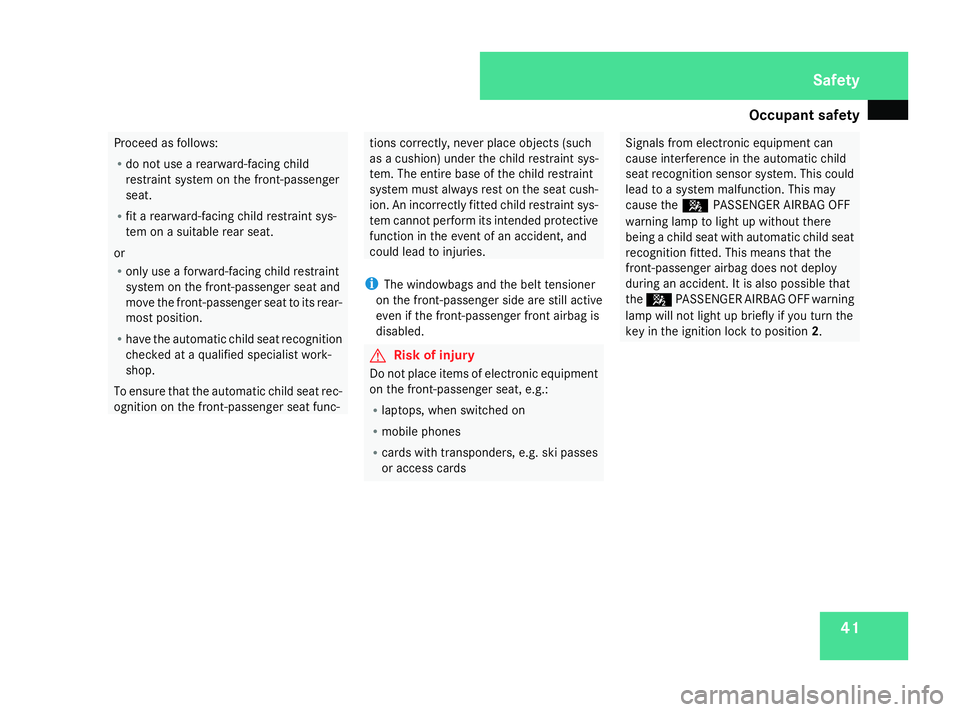
Occupant safety
41Proceed as follows:
R
do not use a rearward-facing child
restraint system on the front-passenger
seat.
R fit a rearward-facing child restraint sys-
tem on a suitable rear seat.
or
R only use a forward-facing child restraint
system on the front-passenger seat and
move the front-passenger seat to its rear-
most position.
R have the automatic child seat recognition
checked at a qualified specialist work-
shop.
To ensure that the automatic child seat rec-
ognition on the front-passenger seat func- tions correctly, never place objects (such
as a cushion) under the child restraint sys-
tem. The entire base of the child restraint
system must always rest on the seat cush-
ion. An incorrectly fitted child restraint sys-
tem cannot perform its intended protective
function in the event of an accident, and
could lead to injuries.
i The windowbags and the belt tensioner
on the front-passenger side are still active
even if the front-passenger front airbag is
disabled. G
Risk of injury
Do not place items of electronic equipment
on the front-passenger seat, e.g.:
R laptops, when switched on
R mobile phones
R cards with transponders, e.g. ski passes
or access cards Signals from electronic equipment can
cause interference in the automatic child
seat recognition sensor system. This could
lead to a system malfunction. This may
cause the
5PASSENGER AIRBAG OFF
warning lamp to light up without there
being a child seat with automatic child seat
recognition fitted. This means that the
front-passenger airbag does not deploy
during an accident. It is also possible that
the 5 PASSENGER AIRBAG OFF warning
lamp will not light up briefly if you turn the
key in the ignition lock to position 2. Safety
463_AKB; 1; 8, en-GB
wobuchh,
Version: 2.10.6 2008-07-17T15:19:41+02:00 - Seite 41 ZDateiname: 6515_4091_02_buchblock.pdf; preflight
Page 45 of 293
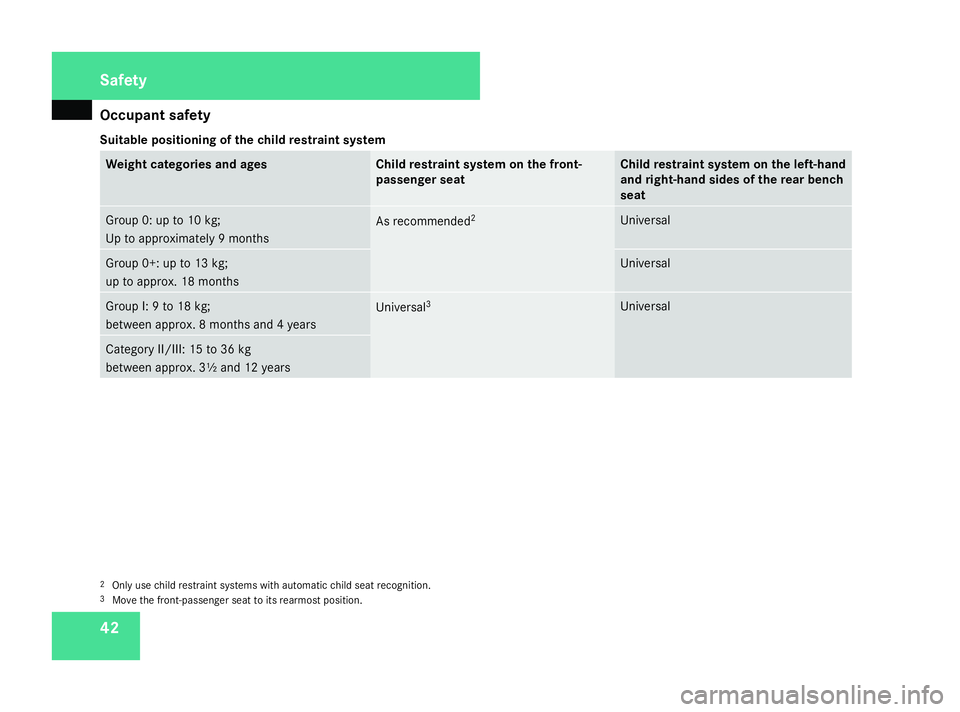
Occupant safety
42
Suitable positioning of the child restraint system Weight categories and ages Child restraint system on the front-
passenger seat Child restraint system on the left-hand
and right-hand sides of the rear bench
seat
Group 0: up to 10 kg;
Up to approximately 9 months
As recommended
2 Universal
Group 0+: up to 13 kg;
up to approx. 18 months Universal
Group I: 9 to 18 kg;
between approx. 8 months and 4 years Universal
3 Universal
Category II/III: 15 to 36 kg
between approx. 3½ and 12 years
2
Only use child restraint systems with automatic child seat recognition.
3 Move the front-passenger seat to its rearmost position. Safety
463_AKB; 1; 8, en-GB
wobuchh,
Version: 2.10.6 2008-07-17T15:19:41+02:00 - Seite 42Dateiname: 6515_4091_02_buchblock.pdf; preflight
Page 46 of 293
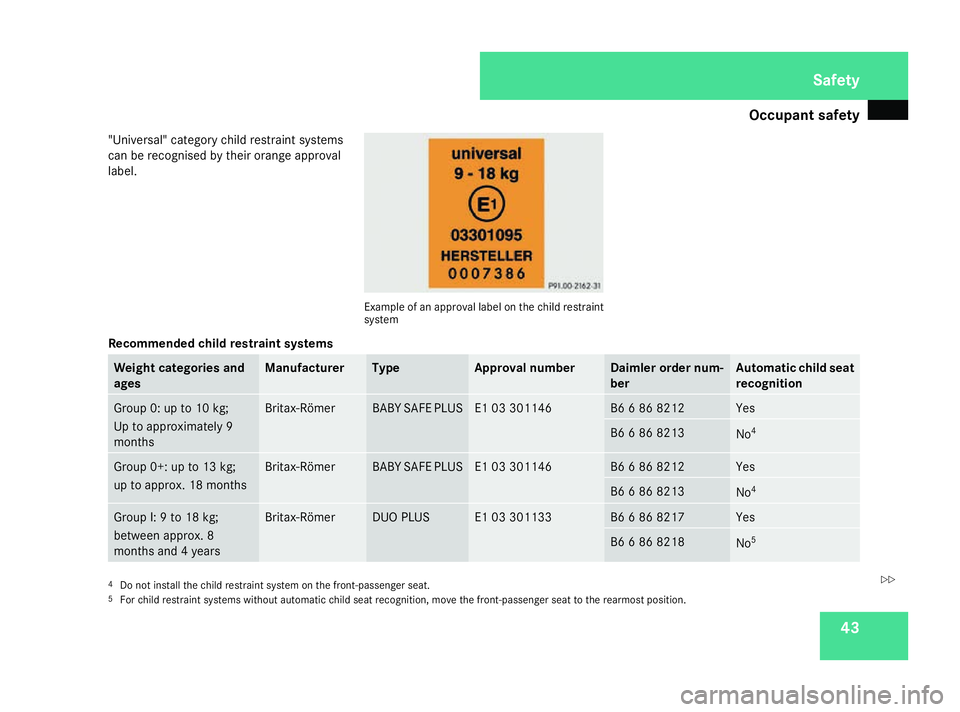
Occupant safety
43
"Universal" category child restraint systems
can be recognised by their orange approval
label. Example of an approval label on the child restraint
system
Recommended child restraint systems Weight categories and
ages Manufacturer Type Approval number Daimler order num-
ber Automatic child seat
recognition
Group 0: up to 10 kg;
Up to approximately 9
months Britax-Römer BABY SAFE PLUS E1 03 301146 B6 6 86 8212 Yes
B6 6 86 8213
No
4 Group 0+: up to 13 kg;
up to approx. 18 months Britax-Römer BABY SAFE PLUS E1 03 301146 B6 6 86 8212 Yes
B6 6 86 8213
No
4 Group I: 9 to 18 kg;
between approx. 8
months and 4 years Britax-Römer DUO PLUS E1 03 301133 B6 6 86 8217 Yes
B6 6 86 8218
No
5 4
Do not install the child restraint system on the front-passenger seat.
5 For child restraint systems without automatic child seat recognition, move the front-passenger seat to the rearmost position. Safety
463_AKB; 1; 8, en-GB
wobuchh, Version: 2.10.6 2008-07-17T15:19:41+02:00 - Seite 43 ZDateiname: 6515_4091_02_buchblock.pdf; preflight
Page 47 of 293
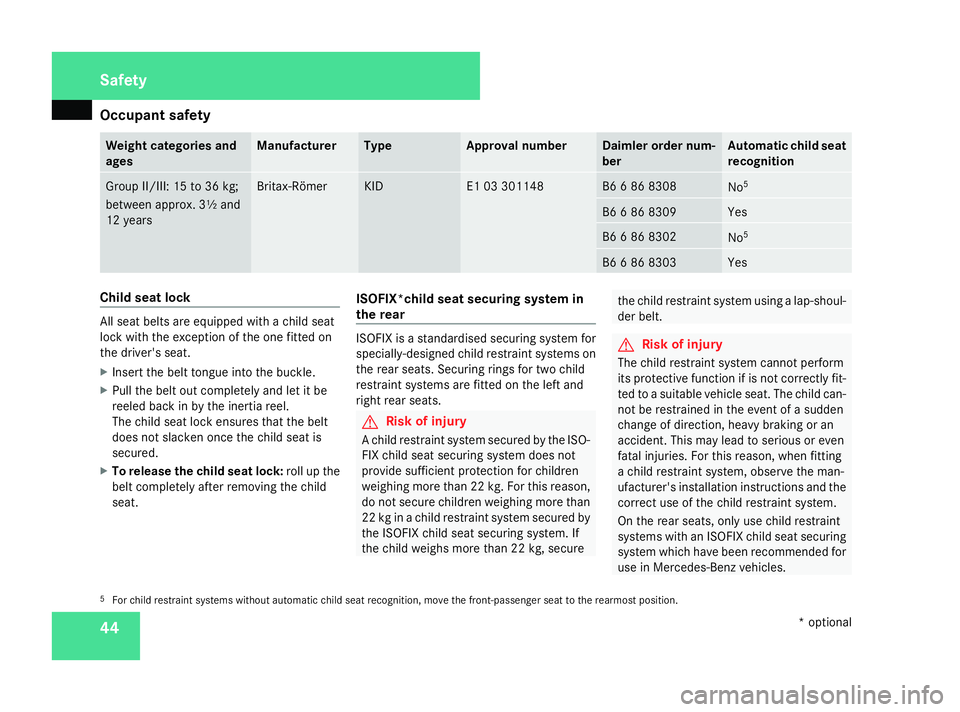
Occupant safety
44 Weight categories and
ages Manufacturer Type Approval number Daimler order num-
ber Automatic child seat
recognition
Group II/III: 15 to 36 kg;
between approx. 3½ and
12 years Britax-Römer KID E1 03 301148 B6 6 86 8308
No
5 B6 6 86 8309 Yes
B6 6 86 8302
No
5 B6 6 86 8303 Yes
Child seat lock
All seat belts are equipped with a child seat
lock with the exception of the one fitted on
the driver's seat.
X Insert the belt tongue into the buckle.
X Pull the belt out completely and let it be
reeled back in by the inertia reel.
The child seat lock ensures that the belt
does not slacken once the child seat is
secured.
X To release the child seat lock: roll up the
belt completely after removing the child
seat. ISOFIX*child seat securing system in
the rear ISOFIX is a standardised securing system for
specially-designed child restraint systems on
the rear seats. Securing rings for two child
restraint systems are fitted on the left and
right rear seats. G
Risk of injury
A child restraint system secured by the ISO-
FIX child seat securing system does not
provide sufficient protection for children
weighing more than 22 kg. For this reason,
do not secure children weighing more than
22 kg in a child restraint system secured by
the ISOFIX child seat securing system. If
the child weighs more than 22 kg, secure the child restraint system using a lap-shoul-
der belt.
G
Risk of injury
The child restraint system cannot perform
its protective function if is not correctly fit-
ted to a suitable vehicle seat. The child can-
not be restrained in the event of a sudden
change of direction, heavy braking or an
accident. This may lead to serious or even
fatal injuries. For this reason, when fitting
a child restraint system, observe the man-
ufacturer's installation instructions and the
correct use of the child restraint system.
On the rear seats, only use child restraint
systems with an ISOFIX child seat securing
system which have been recommended for
use in Mercedes-Benz vehicles.
5 For child restraint systems without automatic child seat recognition, move the front-passenger seat to the rearmost position. Safety
* optional
463_AKB; 1; 8, en-GB
wobuchh,
Version: 2.10.6 2008-07-17T15:19:41+02:00 - Seite 44Dateiname: 6515_4091_02_buchblock.pdf; preflight
Page 48 of 293
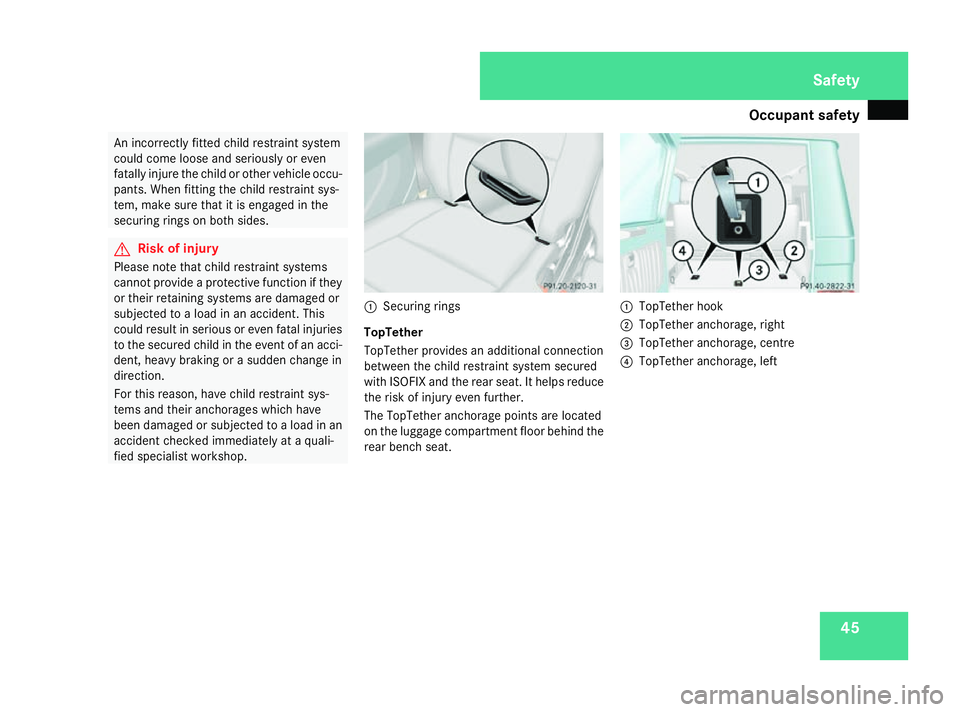
Occupant safety
45An incorrectly fitted child restraint system
could come loose and seriously or even
fatally injure the child or other vehicle occu-
pants. When fitting the child restraint sys-
tem, make sure that it is engaged in the
securing rings on both sides. G
Risk of injury
Please note that child restraint systems
cannot provide a protective function if they
or their retaining systems are damaged or
subjected to a load in an accident. This
could result in serious or even fatal injuries
to the secured child in the event of an acci-
dent, heavy braking or a sudden change in
direction.
For this reason, have child restraint sys-
tems and their anchorages which have
been damaged or subjected to a load in an
accident checked immediately at a quali-
fied specialist workshop. 1
Securing rings
TopTether
TopTether provides an additional connection
between the child restraint system secured
with ISOFIX and the rear seat. It helps reduce
the risk of injury even further.
The TopTether anchorage points are located
on the luggage compartment floor behind the
rear bench seat. 1
TopTether hook
2 TopTether anchorage, right
3 TopTether anchorage, centre
4 TopTether anchorage, left Safety
463_AKB; 1; 8, en-GB
wobuchh, Version: 2.10.6 2008-07-17T15:19:41+02:00 - Seite 45 ZDateiname: 6515_4091_02_buchblock.pdf; preflight
Page 49 of 293
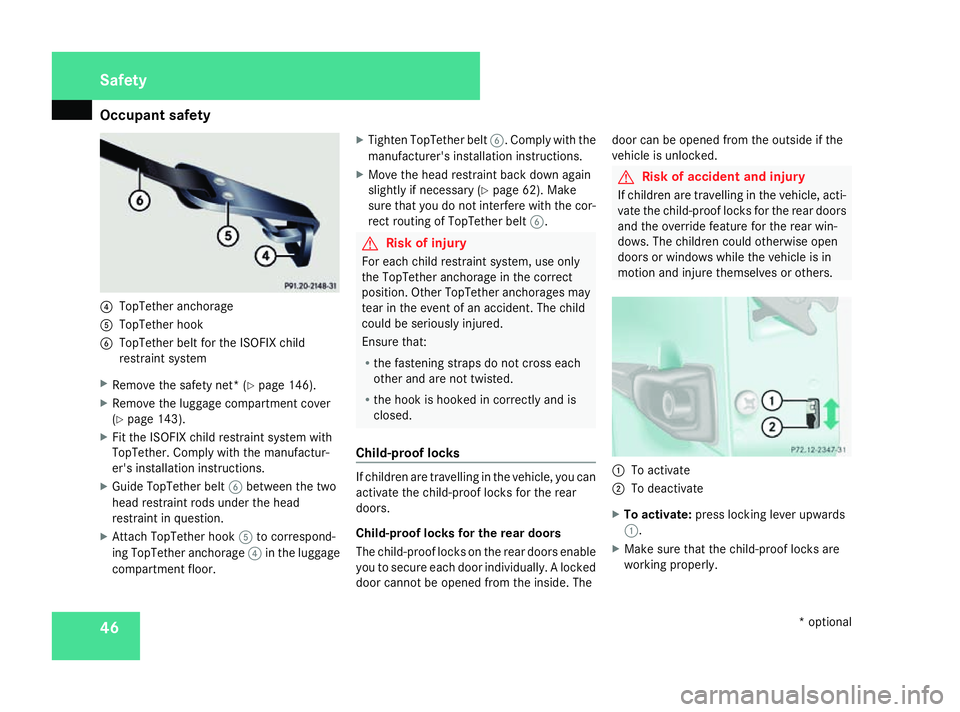
Occupant safety
464
TopTether anchorage
5 TopTether hook
6 TopTether belt for the ISOFIX child
restraint system
X Remove the safety net* (Y page 146).
X Remove the luggage compartment cover
(Y page 143).
X Fit the ISOFIX child restraint system with
TopTether. Comply with the manufactur-
er's installation instructions.
X Guide TopTether belt 6between the two
head restraint rods under the head
restraint in question.
X Attach TopTether hook 5to correspond-
ing TopTether anchorage 4in the luggage
compartment floor. X
Tighten TopTether belt 6. Comply with the
manufacturer's installation instructions.
X Move the head restraint back down again
slightly if necessary (Y page 62). Make
sure that you do not interfere with the cor-
rect routing of TopTether belt 6. G
Risk of injury
For each child restraint system, use only
the TopTether anchorage in the correct
position. Other TopTether anchorages may
tear in the event of an accident. The child
could be seriously injured.
Ensure that:
R the fastening straps do not cross each
other and are not twisted.
R the hook is hooked in correctly and is
closed.
Child-proof locks If children are travelling in the vehicle, you can
activate the child-proof locks for the rear
doors.
Child-proof locks for the rear doors
The child-proof locks on the rear doors enable
you to secure each door individually. A locked
door cannot be opened from the inside. Thedoor can be opened from the outside if the
vehicle is unlocked. G
Risk of accident and injury
If children are travelling in the vehicle, acti-
vate the child-proof locks for the rear doors
and the override feature for the rear win-
dows. The children could otherwise open
doors or windows while the vehicle is in
motion and injure themselves or others. 1
To activate
2 To deactivate
X To activate: press locking lever upwards
1.
X Make sure that the child-proof locks are
working properly. Safety
* optional
463_AKB; 1; 8, en-GB
wobuchh,
Version: 2.10.6
2008-07-17T15:19:41+02:00 - Seite 46 Dateiname: 6515_4091_02_buchblock.pdf; preflight
Page 50 of 293
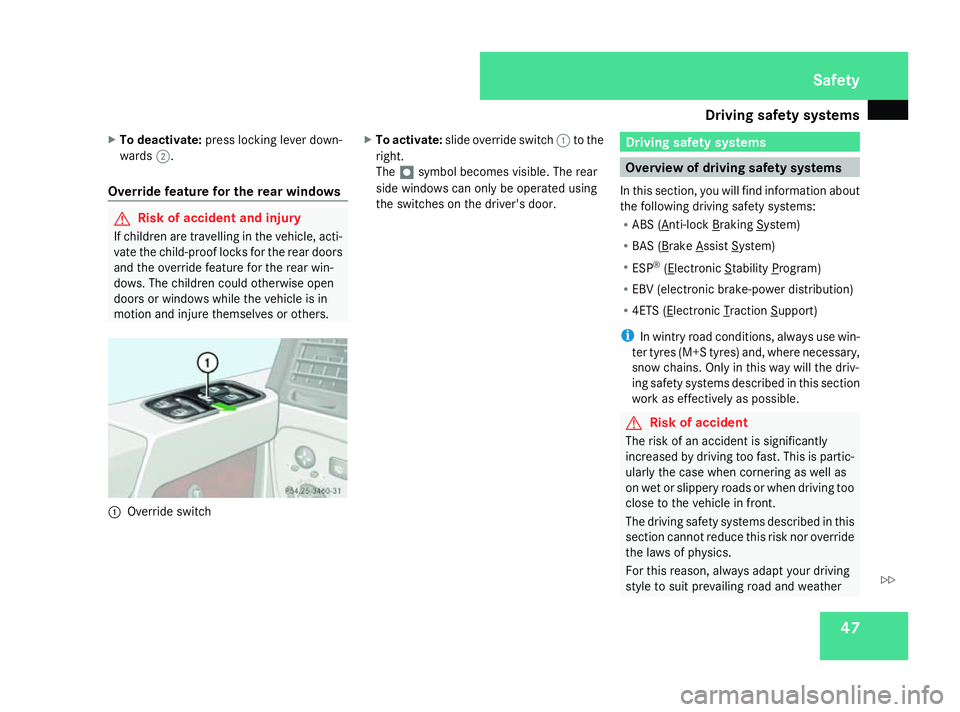
Driving safety sys
tems 47
X
To deactivate: press locking lever down-
wards 2.
Override feature for the rear windows G
Risk of accident and injury
If children are travelling in the vehicle, acti-
vate the child-proof locks for the rear doors
and the override feature for the rear win-
dows. The children could otherwise open
doors or windows while the vehicle is in
motion and injure themselves or others. 1
Override switch X
To activate: slide override switch 1to the
right.
The 7symbol becomes visible. The rear
side windows can only be operated using
the switches on the driver's door. Driving safety systems
Overview of driving safety systems
In this section, you will find information about
the following driving safety systems:
R ABS ( Anti-lock Braking System)
R BAS ( Brake Assist System)
R ESP ®
( Electronic Stability Program)
R EBV (electronic brake-power distribution)
R 4ETS ( Electronic Traction Support)
i In wintry road conditions, always use win-
ter tyres (M+S tyres) and, where necessary,
snow chains. Only in this way will the driv-
ing safety systems described in this section
work as effectively as possible. G
Risk of accident
The risk of an accident is significantly
increased by driving too fast. This is partic-
ularly the case when cornering as well as
on wet or slippery roads or when driving too
close to the vehicle in front.
The driving safety systems described in this
section cannot reduce this risk nor override
the laws of physics.
For this reason, always adapt your driving
style to suit prevailing road and weather Safety
463_AKB; 1; 8, en-GB
wobuchh
,V ersion: 2.10.6
2008-07-17T15:19:41+02:00 - Seite 47 ZDateiname: 6515_4091_02_buchblock.pdf; preflight
Page 51 of 293
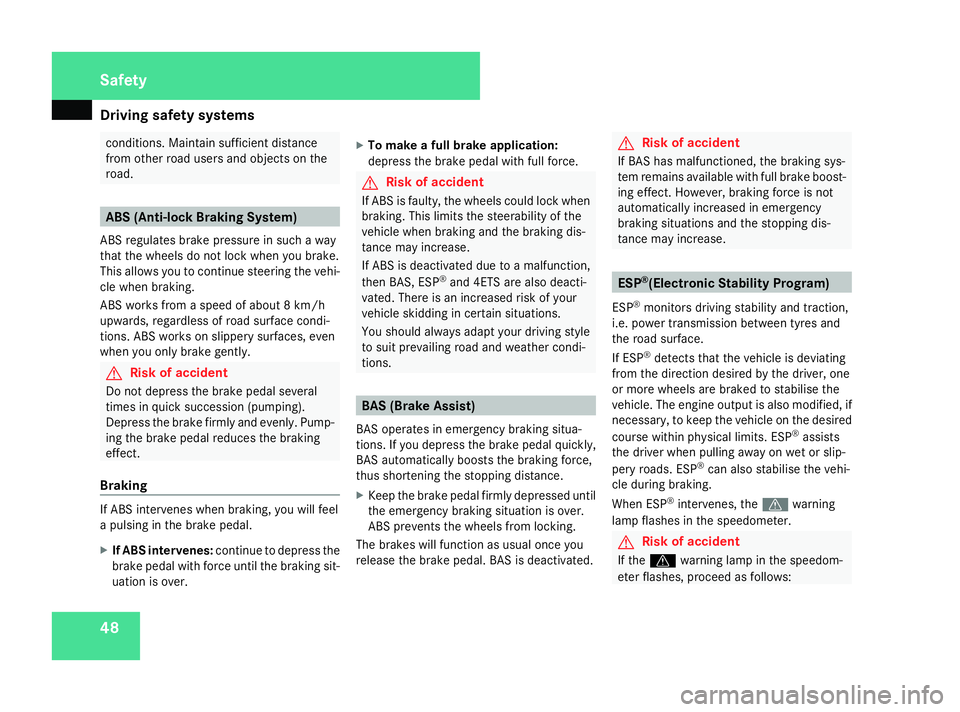
Driving safety sys
tems48 conditions. Maintain sufficient distance
from other road users and objects on the
road. ABS (Anti-lock Braking System)
ABS regulates brake pressure in such a way
that the wheels do not lock when you brake.
This allows you to continue steering the vehi-
cle when braking.
ABS works from a speed of about 8 km/h
upwards, regardless of road surface condi-
tions. ABS works on slippery surfaces, even
when you only brake gently. G
Risk of accident
Do not depress the brake pedal several
times in quick succession (pumping).
Depress the brake firmly and evenly. Pump-
ing the brake pedal reduces the braking
effect.
Braking If ABS intervenes when braking, you will feel
a pulsing in the brake pedal.
X If ABS intervenes: continue to depress the
brake pedal with force until the braking sit-
uation is over. X
To make a full brake application:
depress the brake pedal with full force. G
Risk of accident
If ABS is faulty, the wheels could lock when
braking. This limits the steerability of the
vehicle when braking and the braking dis-
tance may increase.
If ABS is deactivated due to a malfunction,
then BAS, ESP ®
and 4ETS are also deacti-
vated. There is an increased risk of your
vehicle skidding in certain situations.
You should always adapt your driving style
to suit prevailing road and weather condi-
tions. BAS (Brake Assist)
BAS operates in emergency braking situa-
tions. If you depress the brake pedal quickly,
BAS automatically boosts the braking force,
thus shortening the stopping distance.
X Keep the brake pedal firmly depressed until
the emergency braking situation is over.
ABS prevents the wheels from locking.
The brakes will function as usual once you
release the brake pedal. BAS is deactivated. G
Risk of accident
If BAS has malfunctioned, the braking sys-
tem remains available with full brake boost-
ing effect. However, braking force is not
automatically increased in emergency
braking situations and the stopping dis-
tance may increase. ESP
®
(Electronic Stability Program)
ESP ®
monitors driving stability and traction,
i.e. power transmission between tyres and
the road surface.
If ESP ®
detects that the vehicle is deviating
from the direction desired by the driver, one
or more wheels are braked to stabilise the
vehicle. The engine output is also modified, if
necessary, to keep the vehicle on the desired
course within physical limits. ESP ®
assists
the driver when pulling away on wet or slip-
pery roads. ESP ®
can also stabilise the vehi-
cle during braking.
When ESP ®
intervenes, the vwarning
lamp flashes in the speedometer. G
Risk of accident
If the v warning lamp in the speedom-
eter flashes, proceed as follows: Safety
463_AKB; 1; 8, en-GB
wobuchh
,V ersion: 2.10.6
2008-07-17T15:19:41+02:00 - Seite 48 Dateiname: 6515_4091_02_buchblock.pdf; preflight
Page 52 of 293
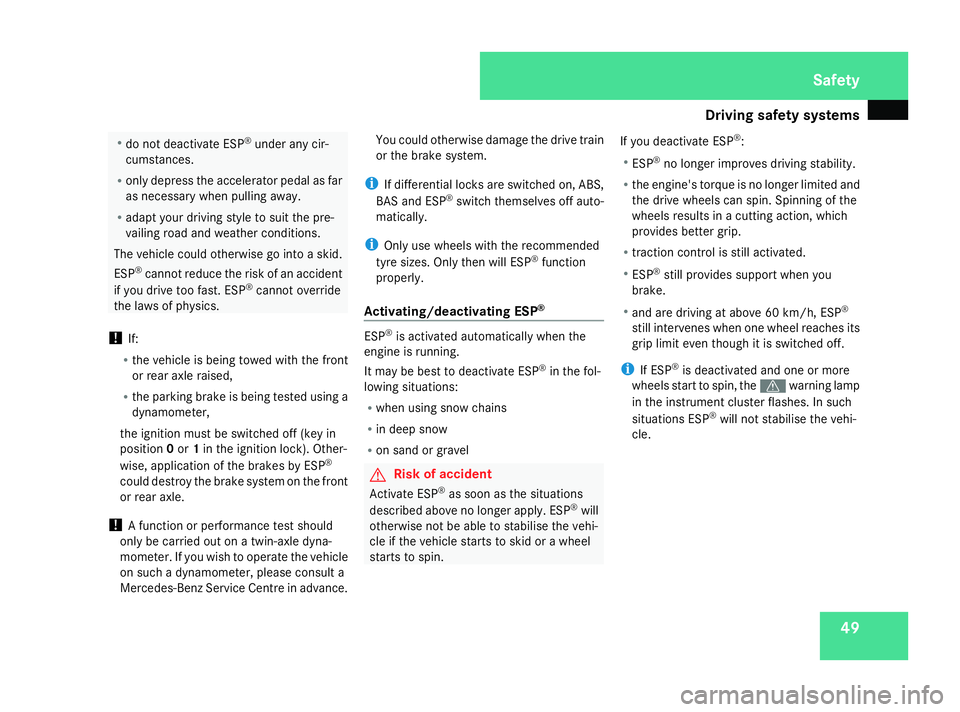
Driving safety sys
tems 49R
do not deactivate ESP ®
under any cir-
cumstances.
R only depress the accelerator pedal as far
as necessary when pulling away.
R adapt your driving style to suit the pre-
vailing road and weather conditions.
The vehicle could otherwise go into a skid.
ESP ®
cannot reduce the risk of an accident
if you drive too fast. ESP ®
cannot override
the laws of physics.
! If:
R the vehicle is being towed with the front
or rear axle raised,
R the parking brake is being tested using a
dynamometer,
the ignition must be switched off (key in
position 0or 1in the ignition lock). Other-
wise, application of the brakes by ESP ®
could destroy the brake system on the front
or rear axle.
! A function or performance test should
only be carried out on a twin-axle dyna-
mometer. If you wish to operate the vehicle
on such a dynamometer, please consult a
Mercedes-Benz Service Centre in advance. You could otherwise damage the drive train
or the brake system.
i If differential locks are switched on, ABS,
BAS and ESP ®
switch themselves off auto-
matically.
i Only use wheels with the recommended
tyre sizes. Only then will ESP ®
function
properly.
Activating/deactivating ESP ® ESP
®
is activated automatically when the
engine is running.
It may be best to deactivate ESP ®
in the fol-
lowing situations:
R when using snow chains
R in deep snow
R on sand or gravel G
Risk of accident
Activate ESP ®
as soon as the situations
described above no longer apply. ESP ®
will
otherwise not be able to stabilise the vehi-
cle if the vehicle starts to skid or a wheel
starts to spin. If you deactivate ESP
®
:
R ESP ®
no longer improves driving stability.
R the engine's torque is no longer limited and
the drive wheels can spin. Spinning of the
wheels results in a cutting action, which
provides better grip.
R traction control is still activated.
R ESP ®
still provides support when you
brake.
R and are driving at above 60 km/h, ESP ®
still intervenes when one wheel reaches its
grip limit even though it is switched off.
i If ESP ®
is deactivated and one or more
wheels start to spin, the vwarning lamp
in the instrument cluster flashes. In such
situations ESP ®
will not stabilise the vehi-
cle. Safety
463_AKB; 1; 8, en-GB
wobuchh
,V ersion: 2.10.6
2008-07-17T15:19:41+02:00 - Seite 49 ZDateiname: 6515_4091_02_buchblock.pdf; preflight
Page 53 of 293
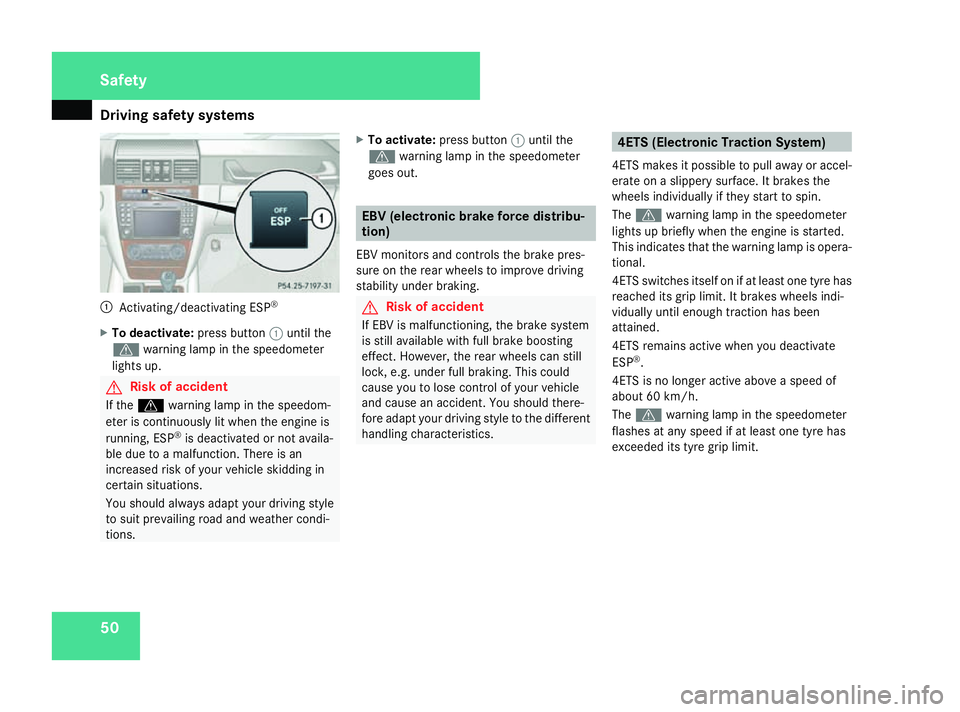
Driving safety sys
tems501
Activating/deactivating ESP ®
X To deactivate: press button1until the
v warning lamp in the speedometer
lights up. G
Risk of accident
If the v warning lamp in the speedom-
eter is continuously lit when the engine is
running, ESP ®
is deactivated or not availa-
ble due to a malfunction. There is an
increased risk of your vehicle skidding in
certain situations.
You should always adapt your driving style
to suit prevailing road and weather condi-
tions. X
To activate: press button 1until the
v warning lamp in the speedometer
goes out. EBV (electronic brake force distribu-
tion)
EBV monitors and controls the brake pres-
sure on the rear wheels to improve driving
stability under braking. G
Risk of accident
If EBV is malfunctioning, the brake system
is still available with full brake boosting
effect. However, the rear wheels can still
lock, e.g. under full braking. This could
cause you to lose control of your vehicle
and cause an accident. You should there-
fore adapt your driving style to the different
handling characteristics. 4ETS (Electronic Traction System)
4ETS makes it possible to pull away or accel-
erate on a slippery surface. It brakes the
wheels individually if they start to spin.
The v warning lamp in the speedometer
lights up briefly when the engine is started.
This indicates that the warning lamp is opera-
tional.
4ETS switches itself on if at least one tyre has
reached its grip limit. It brakes wheels indi-
vidually until enough traction has been
attained.
4ETS remains active when you deactivate
ESP ®
.
4ETS is no longer active above a speed of
about 60 km/h.
The v warning lamp in the speedometer
flashes at any speed if at least one tyre has
exceeded its tyre grip limit. Safety
463_AKB; 1; 8, en-GB
wobuchh
,V ersion: 2.10.6
2008-07-17T15:19:41+02:00 - Seite 50 Dateiname: 6515_4091_02_buchblock.pdf; preflight